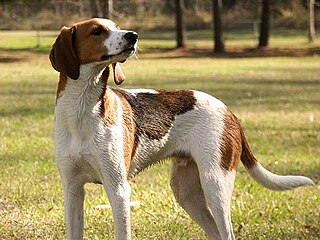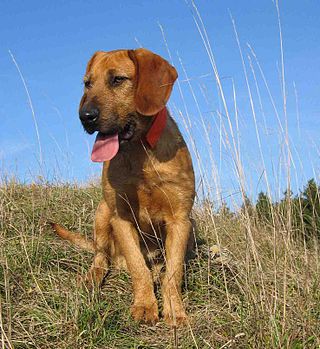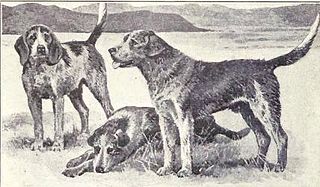
The Beagle is a breed of small scent hound, similar in appearance to the much larger foxhound. The beagle was developed primarily for hunting hare, known as beagling. Possessing a great sense of smell and superior tracking instincts, the beagle is the primary breed used as a detection dog for prohibited agricultural imports and foodstuffs in quarantine around the world. The beagle is a popular pet due to its size, good temper, and a lack of inherited health problems.

The Harrier is a medium-sized dog breed of the hound class, used for hunting hares by trailing them. It resembles an English Foxhound but is slightly smaller, though not as small as a Beagle. The breed has been used since the mid 13th century.

A hound is a type of hunting dog used by hunters to track or chase prey.

The Basset Hound is a short-legged breed of dog in the hound family. The Basset is a scent hound that was originally bred for the purpose of hunting hare. Their sense of smell and ability to ground-scent is second only to the Bloodhound.

Scent hounds are a type of hound that primarily hunts by scent rather than sight. These breeds are hunting dogs and are generally regarded as having some of the most sensitive noses among dogs. Scent hounds specialize in following scent or smells. Most of them tend to have long, drooping ears and large nasal cavities to enhance smell sensitivity. They need to have relatively high endurance to be able to keep track of scent over long distances and rough terrain. It is believed that they were first bred by the Celts by crossbreeding mastiff-type dogs with sighthounds. The first established scent hounds were St. Hubert Hounds bred by monks in Belgium during the Middle Ages.

A coonhound, colloquially a coon dog, is a type of scenthound, a member of the hound group. They are an American type of hunting dog developed for the hunting of raccoons and also for feral pigs, bobcats, cougars, and bears. There are six distinct breeds of coonhound.

The Basset Fauve de Bretagne is a short-legged hunting breed of dog of the scent hound type, originally from Brittany, a historical duchy of France.

Beagling is mainly the hunting of hares and rabbits by beagles using their strong sense of smell. A beagle pack is usually followed on foot, but in a few cases mounted. Beagling is often enjoyed by 'retired' fox hunters who have either sustained too many injuries or lost the agility to ride horseback, or who enjoy the outdoors and the camaraderie of the hunt. It is also traditionally a way for young men and women to learn how to handle hounds on a smaller scale before they go on to hunt with foxhounds.

The Otterhound is an English dog breed. It is a scent hound and is currently recognised by the Kennel Club as a Vulnerable Native Breed with around 600 animals worldwide.

The Grand Bleu de Gascogne is a breed of hounds of the scenthound type, originating in France and used for hunting in packs. Today's breed is the descendant of a very old type of large hunting dog, and is an important breed in the ancestry of many other hounds.

The Petit Basset Griffon Vendéen, or PBGV, is a breed of dog of the scent hound type, bred to trail hares in bramble-filled terrain of the Vendée district of France. The breed is known in the United States as "Petit" or "PBGV," in England as "Roughie," and in Denmark as "Griffon" or "Petit". The PBGV is one of six types of "basset"-type breeds recognised by the Fédération Cynologique Internationale (FCI).

The Treeing Walker Coonhound is a breed of hound descended from the English and American Foxhounds. The breed originated in the United States when a stolen dog known as "Tennessee Lead" was crossed into the Walker Hound in the 19th century. The Treeing Walker Coonhound was recognized officially as a breed by the United Kennel Club in 1945 and by the American Kennel Club in 2012.

The Basset Bleu de Gascogne, also known as the Blue Gascony Basset, is a long-backed, short legged breed of dog of the hound type. A French native breed, it is rare outside its homeland. It is recognized internationally by the Fédération Cynologique Internationale, in the UK by The Kennel Club, and by the United Kennel Club in the United States. The "bleu" of its name is a reference to its coat which has a ticked appearance.

The Styrian Coarse-haired Hound is a breed of medium-sized hound dog originated in the Austrian province of Styria. It is bred as a scenthound, for hunting boar in mountainous terrain. The breed is one of the large Austrian Bracke.

The Southern Hound was a breed of dog that existed in Britain probably until sometime in the 19th century, now extinct. The exact date of its extinction is not known; it is likely that it was gradually interbred with other breeds until the genuine Southern Hound bloodline ceased to exist.

The Welsh Hound is a breed of hunting dog of the foxhound type, indigenous to Wales.

The Basset Artésien Normand is a short legged hound type dog developed in France. The word basset refers to short-legged hounds.

The Warwickshire Hunt is an English fox hunting pack founded in 1791.

The West Country Harrier, sometimes called Somerset Harrier, is a breed of scent hound from the south west of England that is used to hunt hare in packs. The West Country Harrier is often considered to be a variety of the more common Harrier breed, which is sometimes referred to as the Studbook Harrier.

Bassets are a sub-type of scenthound deliberately bred with short legs, that are used for hunting where the hunters accompany the hunting hounds on foot.



















